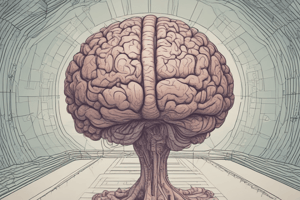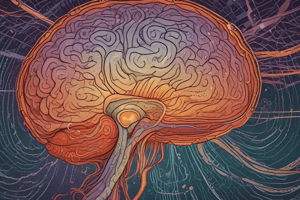Podcast
Questions and Answers
Which cranial nerve is primarily responsible for the sensory modality of smell?
Which cranial nerve is primarily responsible for the sensory modality of smell?
- Optic (II)
- Olfactory (I) (correct)
- Glossopharyngeal (IX)
- Vagus (X)
Which cranial nerve is classified as a purely motor nerve?
Which cranial nerve is classified as a purely motor nerve?
- Olfactory (I)
- Hypoglossal (XII) (correct)
- Vestibulocochlear (VIII)
- Optic (II)
Which function is NOT associated with the Vestibulocochlear nerve?
Which function is NOT associated with the Vestibulocochlear nerve?
- Balance
- Special sensory functions
- Taste (correct)
- Hearing
Which cranial nerve is considered the shortest cranial nerve?
Which cranial nerve is considered the shortest cranial nerve?
What is the primary sensory function of the cranial nerve classified as the 'first' cranial nerve?
What is the primary sensory function of the cranial nerve classified as the 'first' cranial nerve?
What is anosmia?
What is anosmia?
Which cranial nerve is primarily responsible for the sense of smell?
Which cranial nerve is primarily responsible for the sense of smell?
Which ganglion is involved in sensing blood pressure?
Which ganglion is involved in sensing blood pressure?
The solitary tract nucleus is associated with which type of sensory information?
The solitary tract nucleus is associated with which type of sensory information?
What kind of information does the vagus nerve ganglion receive?
What kind of information does the vagus nerve ganglion receive?
Qualitative odor sensation can include which of the following?
Qualitative odor sensation can include which of the following?
Which cranial nerve is associated with somato-sensory overtones of odorants?
Which cranial nerve is associated with somato-sensory overtones of odorants?
The relationship between olfaction, salivation, and taste can be illustrated by which example?
The relationship between olfaction, salivation, and taste can be illustrated by which example?
What is the primary function of the lateral rectus muscle?
What is the primary function of the lateral rectus muscle?
Which cranial nerve is responsible for innervating the lateral rectus muscle?
Which cranial nerve is responsible for innervating the lateral rectus muscle?
Where does the abducens nucleus reside?
Where does the abducens nucleus reside?
What type of muscle is the levator palpebrae superioris?
What type of muscle is the levator palpebrae superioris?
Which structure receives afferent corticonuclear fibers from the cerebral hemispheres?
Which structure receives afferent corticonuclear fibers from the cerebral hemispheres?
What is the primary role of the superior colliculus in relation to the cranial nerves mentioned?
What is the primary role of the superior colliculus in relation to the cranial nerves mentioned?
Which cranial nerves are directly linked by the medial longitudinal fasciculus?
Which cranial nerves are directly linked by the medial longitudinal fasciculus?
What is unique about the abducens nerve compared to other cranial nerves?
What is unique about the abducens nerve compared to other cranial nerves?
How does the abducens nerve affect eye movement?
How does the abducens nerve affect eye movement?
What anatomical structure does the abducens nerve pass through to enter the orbit?
What anatomical structure does the abducens nerve pass through to enter the orbit?
Why does the upper eyelid retract when looking upward?
Why does the upper eyelid retract when looking upward?
What distinguishes the abducens nerve in terms of its size among cranial nerves?
What distinguishes the abducens nerve in terms of its size among cranial nerves?
What is the path taken by the abducens nerve after it emerges from the midbrain?
What is the path taken by the abducens nerve after it emerges from the midbrain?
What type of neuron primarily makes up the spiral ganglia in the cochlear nerve?
What type of neuron primarily makes up the spiral ganglia in the cochlear nerve?
Which structure is primarily responsible for detecting sound waves that vibrate the eardrums?
Which structure is primarily responsible for detecting sound waves that vibrate the eardrums?
Destructive lesions of the cochlear nerve typically lead to which condition?
Destructive lesions of the cochlear nerve typically lead to which condition?
The medial geniculate body is classified as which type of neuron in the auditory pathway?
The medial geniculate body is classified as which type of neuron in the auditory pathway?
Information from both ears is compared at which structure to localize sound sources?
Information from both ears is compared at which structure to localize sound sources?
Which part of the temporal gyrus is associated with the processing of low-frequency sounds?
Which part of the temporal gyrus is associated with the processing of low-frequency sounds?
A lesion affecting the internal acoustic meatus may lead to dysfunction in which cranial nerves?
A lesion affecting the internal acoustic meatus may lead to dysfunction in which cranial nerves?
What sensory function is primarily associated with the vestibular apparatus?
What sensory function is primarily associated with the vestibular apparatus?
Which of these structures receives afferent impulses associated with hearing?
Which of these structures receives afferent impulses associated with hearing?
What type of hearing loss occurs with irritative lesions of the cochlear nerve?
What type of hearing loss occurs with irritative lesions of the cochlear nerve?
Flashcards are hidden until you start studying
Study Notes
Cranial Nerves Overview
- Cranial nerves are crucial for sensory and motor functions in the head and neck.
- Cranial nerve pathways often involve connections through structures like the superior colliculus and medial longitudinal fasciculus.
Abducens Nerve (CN VI)
- The most slender cranial nerve, responsible for lateral eye movement by innervating the lateral rectus muscle.
- Unique for emerging from the posterior aspect of the brainstem, immediately decussating (crossing over) with the corresponding nerve on the opposite side.
- Travels through the middle cranial fossa, enters the orbit via the orbital fissure.
Eye Movement Coordination
- Looking up involves retraction of the upper eyelid, coordinated by neural signals from the oculomotor nerve (CN III) and the superior rectus muscle.
Vestibulocochlear Nerve (VIII)
- Special sensory nerve responsible for hearing and balance.
- Emerges from the pontomedullary junction and exits via the internal acoustic meatus alongside CN VII.
- Damage at the internal acoustic meatus can lead to hearing loss and facial expression issues.
Olfactory Nerve (I)
- The shortest cranial nerve, derived from the basal forebrain, responsible for the sense of smell.
- Considered the oldest sensory modality; stimuli can provoke rapid responses.
- Anosmia refers to the loss of smell, a condition associated with the olfactory nerve.
Glossopharyngeal Nerve (IX)
- Receives information about blood pressure through its primary sensory ganglion.
- Plays roles in somatomotor, somatosensory, visceromotor, and taste functions.
Vagus Nerve (X)
- Involved in autonomic functions, providing sensory and motor information to thoracic and abdominal organs.
- Assists in functions such as heart rate regulation and reflex actions like salivation.
Accessory Nerve (XI) and Hypoglossal Nerve (XII)
- CN XI is purely motor, innervating muscles of the neck.
- CN XII also serves motor functions, innervating the muscles of the tongue.
Arrangement of Cranial Nerves by Function
- Purely Sensory: Olfactory (I), Optic (II), Vestibulocochlear (VIII).
- Purely Motor: Oculomotor (III), Trochlear (IV), Abducens (VI), Spinal Accessory (XI), Hypoglossal (XII).
Cochlear Nerve and Sound Processing
- Damage to the cochlear nerve can cause sensorineural deafness; irritative lesions may cause tinnitus.
- Sound waves are detected by hair cells within the cochlea, and the auditory pathway involves various nuclei in the brainstem and thalamus.
Taste and Smell Integration
- The facial nerve (VII) contributes to taste sensations from the anterior two-thirds of the tongue.
- Smell influences taste perception, thereby creating a connection between olfactory stimuli and salivation.
Studying That Suits You
Use AI to generate personalized quizzes and flashcards to suit your learning preferences.




